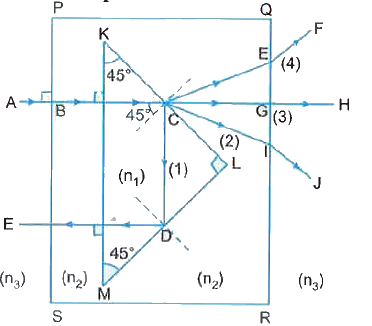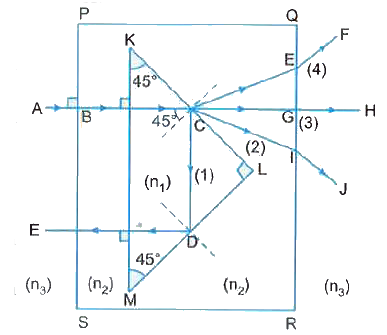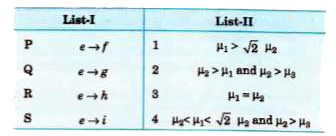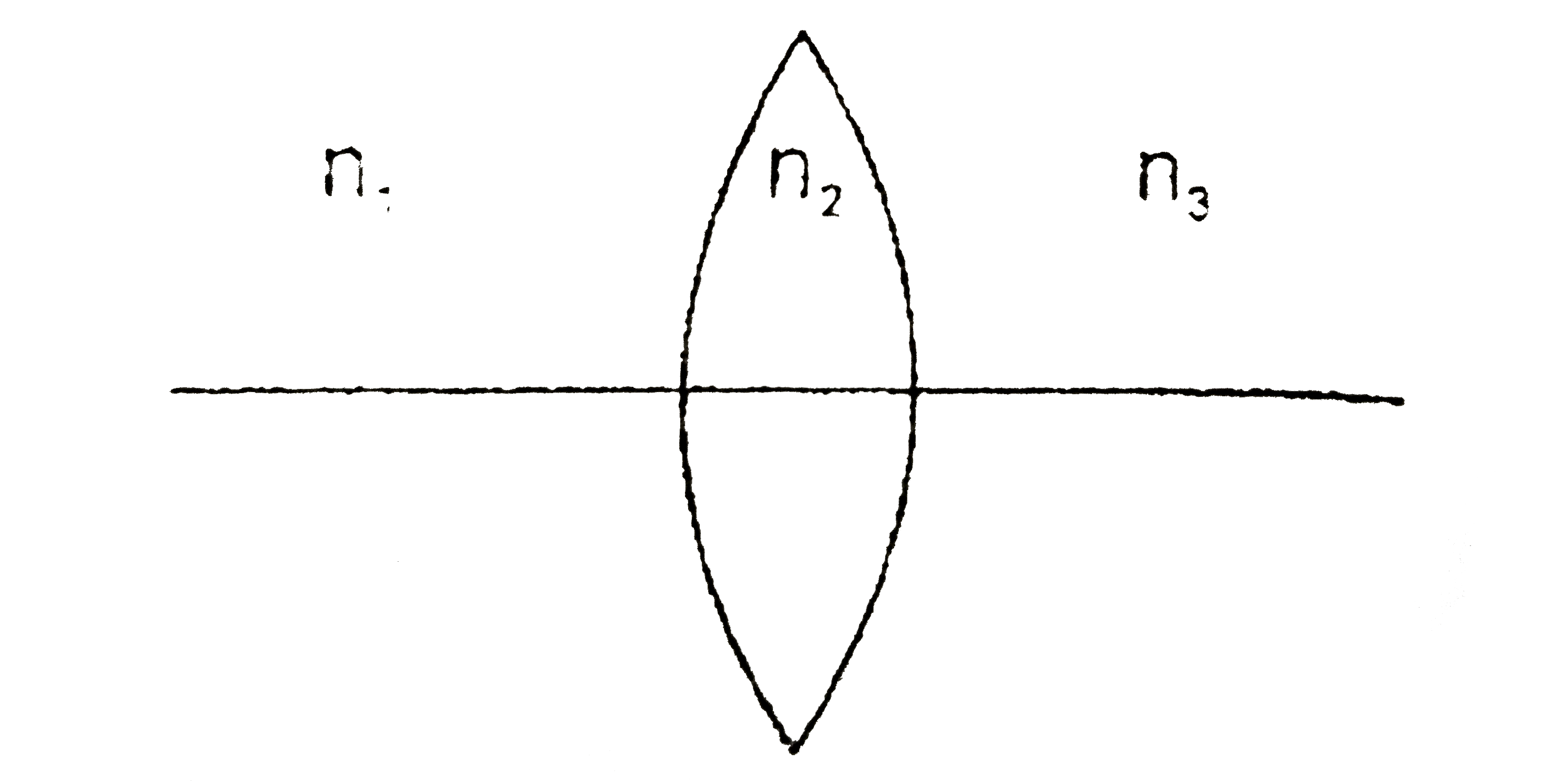A ring angled isosceles prism KLM of refractive index n1 is placed inside a rectangular block PQRS of refractive index n2 as shown in the adjoining Fig. The rectangular box is surrounded by a medium of refractive index n3. A ray of light AB enters the rectangular block normally. Depending upon the relationships between n1,n2andn3. it takes one of the four possible paths.

Under what condition the ray follows the path no. 1 (i.e., path ABCI)?
Since the ray shown as 1 suffers total internal reflection at C as well as D, where angle of incidence is 45∘. It means that value of critical angle ic≤45∘ and it is possible of
n12(=n1n2)≥1sin45∘⇒n1≥√2n2
Topper's Solved these Questions
- RAY OPTICS AND OPTICAL INSTRUMENTSBOOK - U-LIKE SERIESCHAPTER - RAY OPTICS AND OPTICAL INSTRUMENTSEXERCISE - MULTIPLE CHOICE QUESTIONS
39 Videos
- RAY OPTICS AND OPTICAL INSTRUMENTSBOOK - U-LIKE SERIESCHAPTER - RAY OPTICS AND OPTICAL INSTRUMENTSEXERCISE - FILL IN THE BLANKS
20 Videos
- RAY OPTICS AND OPTICAL INSTRUMENTSBOOK - U-LIKE SERIESCHAPTER - RAY OPTICS AND OPTICAL INSTRUMENTSEXERCISE - SELF ASSESSMENT TEST (SECTION B)
3 Videos
- NUCLEIBOOK - U-LIKE SERIESCHAPTER - NUCLEIEXERCISE - Self Assessment Test
10 Videos
- SEMICONDUCTOR ELECTRONICS : MATERIALS, DEVICES AND SIMPLE CIRCUITSBOOK - U-LIKE SERIESCHAPTER - SEMICONDUCTOR ELECTRONICS : MATERIALS, DEVICES AND SIMPLE CIRCUITSEXERCISE - SECTION B
1 Videos
Similar Questions
A ring angled isosceles prism KLM of refractive index n1 is placed inside a rectangular block PQRS of refractive index n2 as shown in the adjoining Fig. The rectangular box is surrounded by a medium of refractive index n3. A ray of light AB enters the rectangular block normally. Depending upon the relationships between n1,n2andn3. it takes one of the four possible paths.

State the condition for light ray to travel along path no. 3 (i.e., path ABCGH).
View SolutionA ring angled isosceles prism KLM of refractive index n1 is placed inside a rectangular block PQRS of refractive index n2 as shown in the adjoining Fig. The rectangular box is surrounded by a medium of refractive index n3. A ray of light AB enters the rectangular block normally. Depending upon the relationships between n1,n2andn3. it takes one of the four possible paths.

What is the condition for light ray to proceed along the path no. 4 (i.e., path ABCEF)?
View Solution
Knowledge Check
A right-angled prism of refractive index μ1, is placed in a rectangular block of refractive index μ2, which is surrounded by a medium of refractive index μ3, as shown in the figure. A ray of light 'e' enters the rectangular block at normal incidence. Depending upon the relationships between μ1,μ2andμ3, it takes one of the four possible paths 'ef','eg','eh'or'ei'.

Match the paths in List I with conditions of refractive indices in List II and select the correct answer using the codes given below the lists:
 APQRS2314BPQRS1243CPQRS4123DPQRS2341
APQRS2314BPQRS1243CPQRS4123DPQRS2341When a lens of refractive index n1 is placed in a liquid of refractive index n2, the lens looks to be disappeared only if
An1=n22Bn1=34n2Cn1=n2Dn1=54n2An equiconvex lens of refractive index n2 is placed such that the refractive index of the surrouding media is as shown. The lens :
 Amust be diverging if n2 is less than the aritmetic mean of n1 and n3Bmust be converging if n2 is greater than the arithmetic mean of n1 and n3Cmay be diverging if n2 is less than the arihmetic mean of n1 and n3Dwill neither be diverging nor converging if n2 is equal to arithmetic mean of n1 and n3
Amust be diverging if n2 is less than the aritmetic mean of n1 and n3Bmust be converging if n2 is greater than the arithmetic mean of n1 and n3Cmay be diverging if n2 is less than the arihmetic mean of n1 and n3Dwill neither be diverging nor converging if n2 is equal to arithmetic mean of n1 and n3
An equiconvex lens of refractive index n2 is placed such that the refractive index of the surrouding media is as shown. The lens :

View SolutionA biconvex thin lens is prepared from glass of refractive index μ2=32. The two conducting surfaces have equal radii of 20 cm each. One of the the surface is silvered from outside to make it reflecting. It is placed in a medium of refractive index μ1=53. It acts as a
View SolutionA ray of light travelling inside a rectangular glass block of refractive index √2 is incident on the glass–air surface at an angle of incidence of 45∘. The refractive index of air is 1. Under these conditions the ray
View SolutionA ray of light travelling inside a rectangular galss block of refractive index √2 is incident glass-air suface at an angle of incidence of 45∘. The refractive index of air is one. Under these conditions, the ray
View SolutionIn a medium of refractive index n1, a monochromatic light of wavelength λ1 is travelling. When it enters in a denser medium of refractive index n2, the wavelength of the light in the second medium is
View Solution
